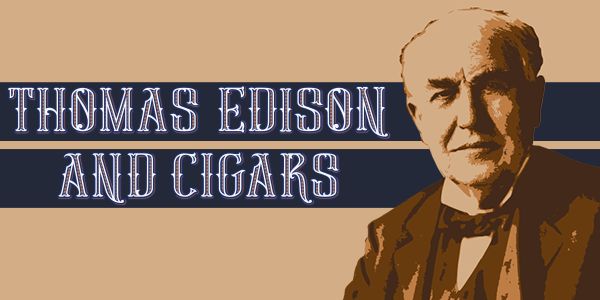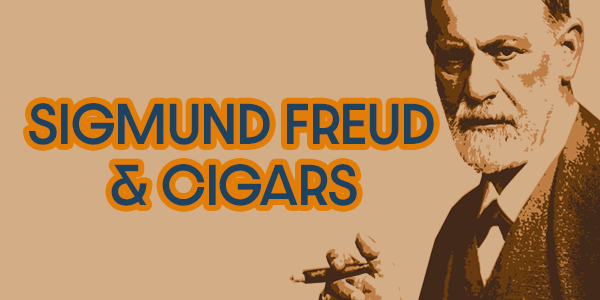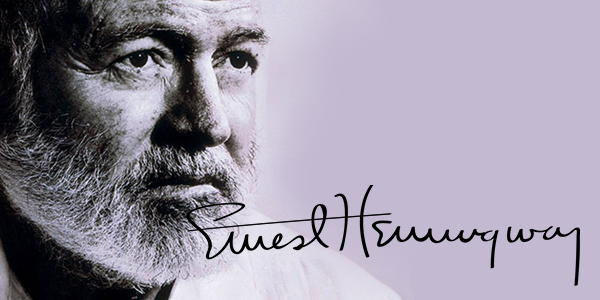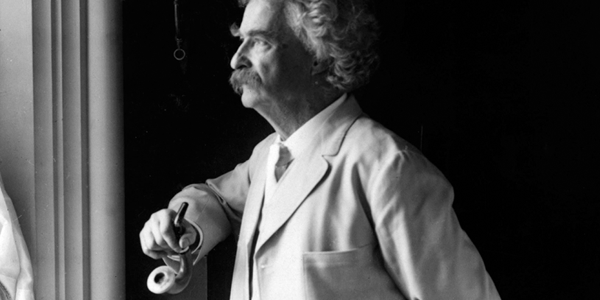Thomas Edison: A Cigar-Smoking Luminary
The next time you light up a cigar and watch as billows of smoke float below the lights in the room, thank prolific inventor and cigar lover Thomas Edison for turning them on. Born February 11, 1847, in Milan, Ohio, Thomas Alva Edison was at the vanguard of a technological revolution, for the bulk of his life, that impacted how modern humans live and communicate – and we’ve been living in its shadow ever since.
A Disability Becomes an Advantage
Edison was raised in Port Huron, Michigan, and taught by his mother. He was a natural entrepreneur, a curious tinkerer, and highly precocious. He lost his hearing as a child, possibly from a series of infections, or possibly from an incident where he was lifted onto a train, by his ears, by a train conductor who was attempting to help him board the train as it pulled away from the station. He recounted a distinctive snap in his head during the incident, and thereafter his hearing faded completely in one ear and nearly completely in the other. Deafness became an unwitting asset to Edison in that he could read and concentrate fiercely for long periods regardless of what was going on around him.
Mastering the Telegraph
Edison began working on the Grand Trunk Railroad at the age of 13 where he developed his astute business acumen, opening a pair of profitable stands that sold newspapers and fruits and vegetables to train commuters. During his time at the railway, Edison saved the young son of a stationmaster from the path of a runaway train. In return, the stationmaster formally trained Edison as a telegraph operator, controlling railway traffic. These skills paid major dividends as the Civil War unfolded and telegraphy became an essential and speedy means of communication. Edison traveled throughout the Midwest during the war, plying his in-demand services. He wasn’t merely an advanced telegrapher, he was obsessed with the equipment, improving its operation, and electricity.
In 1869, he moved to New York City where, when visiting a friend who worked at the Gold & Stock Reporting Telegraph Company, a malfunctioning transmitter proved fortuitous. The company provided gold quotes from the New York Stock Exchange floor to subscribers around the city. Edison stepped in and fixed the transmitting machine by removing a spring which had broken off and become wedged between two gears. Panicked employees gratefully offered him a job on spot. Edison was earning a considerable $100 per month and, by the end of the year, was promoted to superintendent of the company’s plant for three times more money. The stability afforded Edison the resources to enhance the equipment under his care and to feed his insatiable desire to invent.
A bidding war among the barons of Wall Street, who wanted to capitalize on Edison’s advancements, resulted in him receiving $40,000 from Western Union for the rights to his improvements to the gold indicator the telegraph companies relied on. Edison invested this early windfall into an industrial laboratory in Menlo Park, New Jersey. During this period, Edison married Mary Stilwell, in December of 1871, with whom he had three children.
Thomas Edison & Cigars
Edison spent copious hours in his laboratory observing, improving, and creating hundreds of devices, many of which he patented. All the while, he chewed on and smoked heavy cigars. Clouds of smoke erupted over the demonstrations he performed in his lab for investors. He could smoke cigars copiously and had even developed a process for bleaching tobacco leaves to achieve the rich yellowish color that commanded the highest prices for tobacco at the time. The process, however, destroyed the flavor and Edison later abandoned his efforts. He was averse to cigarettes, however, and banned their consumption by employees in his labs, believing their toxicity led to lower efficiency, greater likelihood of accidents, and even brain damage. Automotive innovator Henry Ford advocated Edison’s beliefs and published and distributed his warnings on cigarettes.
Edison Steals the Spotlight
The light bulb, like many of Edison’s inventions, wasn’t invented by Edison from the ground up. Rather, he improved upon, through hundreds of hours of experimentation, the inventions of others – to make them practical and available to the masses and, by consequence, to make them profitable. Failure was never a deterrent, and Edison capitalized on the failed experiments of his contemporaries by extensively researching what they had done wrong, paving a clear path, through the process of elimination, to solutions that worked.
Such was the case of the lightbulb. In the mid-1870s, artificial lighting came from gas fixtures supplied by gas companies controlled by Wall Street barons, whom Edison convinced would become far wealthier by investing in his plans to create light with electricity. Edison famously lured bankers to his laboratory where wafts of cigar smoke filled the room during his early demonstrations of electric lighting.
Following several failed attempts and the waning patience of investors, including J.P. Morgan and William H. Vanderbilt, Edison and his assistant, Charles Batchelor, succeeded in producing light in a vacuum-sealed glass bulb in October of 1879. They utilized a carbonized cotton thread rolled into a thin filament inside the glass. To their surprise, the bulb glowed for over 13 hours, and the age of electric light became a reality.
In the ensuing years, Edison developed the fuses, cable insulation, and usage meters required for the commercial application of electric lighting. The next breakthrough came in April of 1881 when New York City granted Edison permission to build the first power station, in lower Manhattan on Pearl Street. A consummate promoter, Edison sought to power the financial district in a move to impress his investors. Work on the massive project lasted a year and a half, during which time streets were dug up to lay over 80,000 feet of cable. On Monday, September 4, 1882, the switch was thrown at 3 p.m., and 3,000 incandescent lamps ended the gaslight era as the streets of lower Manhattan glowed.
Edison fiercely defended his DC (direct current) system against the AC (alternating current) technology of competitors, including Nikola Tesla and George Westinghouse. DC, however, could only deliver electricity to customers within a mile radius of the plant, requiring more infrastructure and plants. AC won out in the legendary “War of Currents,” because it could transmit current over much longer distances and through cheaper, thinner wires, making it more practical and affordable for consumer distribution.
Thomas Edison : The Father of Audio Video
In Menlo Park, Edison began experimenting with Alexander Graham Bell’s telephone patent which resulted, in 1877, in his invention of the phonograph – a machine that made him a world-famous celebrity. His first phonograph recorded sound on a grooved cylinder wrapped in tin foil, which he later replaced with wax cylinders. Witnesses to early demonstrations of the machine playing back a recorded voice caused them to wonder if supernatural forces were at work and inspired the press to label Edison “The Wizard of Menlo Park.”
He made several improvements to the device in the late 1880s, following his success with electric lighting, and built a manufacturing facility in West Orange, New Jersey, to produce the phonograph. Its popularity grew as a dictation instrument and as a home entertainment device. Edison established recording studios in New York and New Jersey where master recordings of the day’s greatest entertainers were made, and millions of reproductions on wax, and later celluloid, discs were sold to the public.
In 1889, in West Orange, Edison invented the first motion picture camera, the Kinetograph – a wooden structure covered in black tar paper with a hinged roof. The entire building rotated on a circular railway track to capture sunlight throughout the day through the open roof. Rudimentary scenes of an organ grinder with a monkey, a man sneezing, and dancing girls lasted about 90 seconds and could be viewed through a box, outfitted with a peep hole, called the Kinetoscope. Major investors expressed little interest in the invention initially, and Edison neglected to file for patents for it in Europe, where competitors knocked off the device. The oversight prevented Edison from profiting substantially at the dawn of the movie industry. Nonetheless, he lived to invent things, and shunned the greed of the robber barons who supported his work but sought to profit from it at every turn.
Thomas Edison’s Patents
At the time of his death on October 18, 1931, Edison held 1,093 patents. Among his biggest early contributions was the quadruplex – a telegraph that could transmit four signals simultaneously on a single wire, greatly improving the efficiency and reducing the costs of the telegraph. Another, an autographic printing pen for copying documents, became the basis for the first electric tattoo machine, later patented by Samuel O’Reilly in 1891. Edison created the alkaline battery for cars. He manufactured prefab concrete homes, replete with plumbing. He patented a glass tube that could preserve fruit, an electronic vote recorder, and a costly iron-ore separator. He was given credit for scores of others’ inventions, too, because he made them better and he made them available to everyone.







